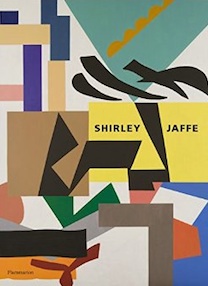By Svetlana Alpers
This is a singularly compelling book about making and looking at painting in our time. Rubinstein, a well-known critic who has been a friend of the artist since youth, writes clearly and directly about Jaffe’s life and her works which are excellently reproduced in the generous plate section. He is up to the challenge presented by Jaffe who is almost as formidable and articulate in words as she is in painting. The combination of Rubinstein and Jaffe (texts and images) offers an unusual opportunity to attend to and think about painting.
Shirley Jaffe is an American artist who (though returning now and then) has lived and worked in Paris since 1949, when she was twenty-six. As she tells it, her life has often been a matter of impulse or happenstance—the sudden idea to take a ship to France with her husband who was supported by the GI Bill, then the lingering in Paris on her own (despite the attraction of New York) enabled by connection to a gallery, sales, commissions, exhibitions. By contrast to a life not lived according to plans, her making of art has been a matter of thought, determination and the hard slow work of practice. Jaffe is ninety-two. It is remarkable that her paintings remain as complex and as rigorous in attending to the world now as ever.
There is much talk these days about art as a global phenomenon—artists are not described as being born somewhere, but rather as being ‘based” somewhere (very often these days in Berlin). There is an embarrassment or perhaps a suspicion about speaking of the nationality of artists and their art. Jaffe is a fascinating instance of a truly dislocated artist (she used the word of herself) which is different from being global (whatever that might be). Habitually unsettled in her life, it is with her art that she settles in. In her works we see the freedom of someone who can paint with the directness (is it a bit of innocence?) of an American, but also with the will or the drive to see a work through to a conclusion found among the French. Jaffe admits to such national propensities insisting, for example, that she does not share the limiting taste for beauty in art which is so French.
Curiously, a year in Berlin in the 60s marked a great turning point in her style—not actually due to the art being made there, but due to discovery of the new, articulate music of Elliot Carter and Xenakis among others. Style, like nationality, is out of fashion these days. Perhaps it is because for high-riding artists a personal singular style is a selling point. Style is found and then promoted rather than being the stuff of the working life of an artist as it was in time past: think of Vermeer brushilly beginning with large paintings of bible or myth and then retreating to the finely tuned woman’s world of his studio; or Cézanne beginning with violently worked human dramas and turning to slowly worked landscapes and still-lives on tables.
Because of the clarity of her thought and of her pictorial decisions, Jaffe’s art is a fascinating primer in style. She began painting in a gestural abstract expressionist manner with which, after Berlin and in the face as it were of American friends in France happily doing that very thing, she broke. It took several years of thought and hard work to invent her new, smoother geometrical style. But the word geometry is too rigid in its sound. Works in Jaffe’s new style display measure, but they are also spontaneous and wittily playful—diverse forms, subtly distinguished by color, jostle for attention within the given shape of each canvas. We may see it as systematic chaos. A white ground, another permutation in style, came in, less beneath than among the forms.
The clear surfaces of the new paintings are the result of laborious work—forms and colors tried, scraped down, the canvas worked at again. More privately, making smaller, quicker works in gouache, Jaffe still lets the old layerings of her gestural performance be. But in the paintings, the gestures of the brush have been transformed into the jump-start within each design.
In her new style suggestions of landscape—both outer and inner—are put aside. She looks outward at the life of things in (mostly) the urban world. Repetition is avoided or rather, since it is a human tendency, it is determinedly worked against. As also is reference. Jaffe’s painted forms may suggest objects but, obdurately, they aren’t. We can say that Jaffe’s paintings create a fascinating second world whose visual presence keeps us alert, on our toes so to speak, when we return from it to the first.
It is surprising, perhaps, that though her sense of design may suggest Matisse, Jaffe is an admirer of Picasso. Indeed, her art, like his, is an art of the breaking of orders and an opening up to possibilities. However, back to Matisse, Jaffe’s art has not a whiff of the violence native to Picasso (as it is also to our world).
Not given her own gallery show in New York until 1990 when she was nearly seventy, Jaffe had a growing reputation in France. She lived through a six year hiatus between shows and finally moved to her new Paris gallery. Jaffe has managed to make her way independently in life and in art. She is exemplary in that, but more to the point is the singular wonder of her painting.
Svetlana Alpers, an artist, critic and renowned art historian, is professor emerita of the history of art at the University of California, Berkeley and a visiting scholar in the Department of Fine Arts at New York University.




